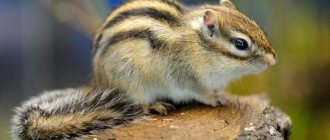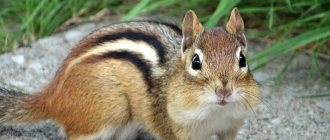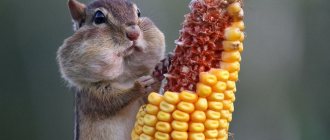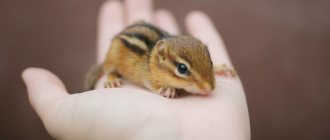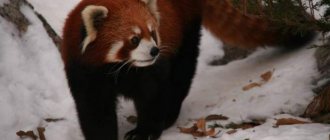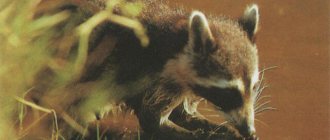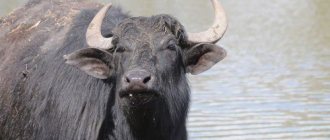The Asian chipmunk is a prominent representative of mammals that belong to the Squirrel family. The small animals actually have a number of similarities with the ordinary squirrel, but if you take a closer look, they can easily be distinguished from each other. Chipmunks stand out from their relatives, first of all, by their habitat. They are the only ones who settled in Eurasia, while the rest can be found in North America.
Description
The body of this animal is quite compact and measures less than 30 centimeters, while the tail can be from 7 to 12 centimeters, and the body itself can be about 15. Its weight is up to one hundred grams, and this weight allows them to be quite mobile.
In general, if we compare the Asian chipmunk and the squirrel (after all, chipmunks belong to the squirrel order, so this comparison looks quite adequate), then the former are faster and more mobile. Although it is difficult for anyone who has seen a squirrel to imagine how rodents can be faster and more active than these mobile tree inhabitants. However, the Asian chipmunk runs fast thanks to its longer front legs compared to its back legs.
In addition, the actual body of these chipmunks is more slender, and this fact also adds mobility. It is quite easy to recognize the animal by its characteristic “shape”, which consists of a general body color in ocher tones, which is combined with five dark stripes located along the back.
Natural enemies
The main natural enemies of chipmunks are small predatory animals and birds of prey. Occasionally, they are also pursued by large predators such as a bear, which seeks to dig up a chipmunk's burrow in search of its winter food reserves.
When people or dogs approach, chipmunks make a jerky “tink” or whistle. At the same time, the animal sits on its hind legs and examines the approaching person. Having allowed him 20-30 steps, the chipmunk runs away and continues repeating the alarm signal while running to notify his relatives of the danger.
Habitat space
Chipmunks are a purely American prerogative, and therefore it is easy to understand the presence in American culture of cartoons and films in which these animals are the main characters. They are typical in North America (where there are 25 different species of chipmunks), but are rare in Eurasia. At the same time, if you wander through the Siberian forests, you still have the opportunity to see quite a lot of Asian chipmunks, because they are densely populated in some regions.
For the most part, Asian chipmunks occupy the forests of the taiga zone. They are located throughout the taiga - from the European part of the country to the Far East. Some even end up in Kamchatka, although in small numbers.
- 35 facts about foxes
- Animals of Brazil
- Tarantula spider
- 34 facts about lions
- Lynx
- 37 facts about cheetahs
It is quite easy to understand where Asian chipmunks will settle by looking at the plants. You need to focus on cedar pines and dwarf trees.
Spreading
The Asian chipmunk is widespread in the taiga zone of Eurasia: from the northeast of the European part of Russia to the Far East (including the Magadan region), Northern Mongolia, the islands of Sakhalin and Hokkaido. It is found in the Southern Kuril Islands, in the mountainous part of East Kazakhstan region. In the Anadyr basin, the habitat extends into the tundra forest zone[2]. It is a self-dispersing species and successfully acclimatizes[3]. Up to the 70-80s. XX century was absent from Kamchatka, for the first time directly on the peninsula it was recorded in the valleys of the Palana and Elovka rivers in 1983 [4] [3], in the northern part of the Kamchatka Territory it constantly lives in the valleys of the Vyvenka, Apuka and Penzhina rivers, but is rare here too. By 2007, it inhabited the Kenozersky Biosphere Reserve. In the northern part of European Russia, the chipmunk as a whole is gradually moving westward. Its isolated settlements have already been noted in the west of the Moscow region in the region of Lake. Deep and near Porechye. Based on the results of molecular genetic studies and similarity in appearance, chipmunks from the Moscow region are most similar to those from Primorye. Based on this, scientists made the assumption that chipmunks captured in the Primorsky Territory were accidentally released here [3].
In the North-East of Russia, the range of the Siberian chipmunk continues with its subspecies - the Yakut chipmunk Tamias sibiricus jacutensis Ognev[2], which in the 1980s penetrated through the Parapolsky valley to the Kamchatka Peninsula[5].
The chipmunk is especially numerous in the cedar-deciduous forests of the Primorsky Territory, where in favorable years 200-300 chipmunks can live per 1 km².
Lifestyle
Based on the above, it is easy to understand food preferences. Chipmunks prefer to eat seeds from pine nuts. If there are none, they will happily eat any other nuts.
Chipmunks are omnivores, meaning they can eat both plant and animal foods. Nutrition is largely determined by seasonality. They prefer green shoots during the growing season and can also collect roots.
From animal food they do not disdain mollusks, spiders and insects. Among the herbal ones, the following preferred options should be noted:
- Korean and Siberian cedar seeds;
- rowan, linden, maple seeds;
- seeds of umbrella and herbaceous plants;
- wheat;
- oats;
- buckwheat
The period of cold weather is caused by chipmunks entering hibernation; they lower their own body temperature and slow down their metabolism. As a result, the chipmunk sleeping in this way takes only a couple of breaths per minute at a body temperature that is about 6 degrees less than normal, but sometimes they wake up, wander half-asleep to their own pantry, eat some goodies from the stored supplies and they go back to sleep until the next time they want to eat.
Asian chipmunks are excellent hoarders and incredibly economical animals. Firstly, they can keep some food with them, as they have amazingly developed cheek pouches. In addition, they collect about 5 kilograms (a significant amount when weighing about a hundred grams) of various provisions for the winter, this includes panicles of cereals and all kinds of seeds and nuts.
Of course, such thriftiness is completely justified, since even relatives - squirrels - often destroy the underground storerooms where the chipmunks so diligently store their provisions. Often sables, wild boars or bears may covet these warehouses.
However, the chipmunks themselves have also adapted quite well to such conditions and it is not so easy to understand where they built their burrow. When an Asian chipmunk digs an underground shelter, it prudently moves the soil away from its burrow, that is, from these “evidences” it is not entirely clear where exactly the digging took place. Also, the burrows have a solid structure and it is difficult to navigate there (if you are not the chipmunk who made this burrow) in the various passages and find something useful for yourself.
Chipmunks are individualists, each of them has their own area and their own burrow, but they do not get along in one burrow. Even if they sit in the same cage, they begin to constantly fight among themselves.
The Nora is somewhat similar to a rather nice apartment, which includes:
- floor lined with down and hay;
- separate bedroom;
- storerooms;
- restroom.
However, they are able to leave such comfort. If the feeding area becomes ineffective, they move to a new one.
Separately, it should be noted the sound alarm system, which is quite developed and diverse. For example, in times of danger, a chipmunk begins to trill or whistle. Females make characteristic sounds during the mating season.
Behavior and habits
Neotamias can climb trees well, but build underground nests with extensive tunnel systems, often with multiple entrances. To conceal the location of the burrow, the eastern chipmunk moves soil to another location using its cheek pouches. It also lines its home with leaves, stones, sticks and other materials . The animal has several sound signals - a trill at a speed of 130 vibrations per minute and low-frequency clicks.
The chipmunk is mostly active during daylight hours, spending most of its day searching for food.
The main diet consists of:
- bulbs;
- seeds;
- fruits;
- nuts;
- green plants;
- mushrooms;
- insects;
- worms;
- bird eggs.
All chipmunks carry food in pouches on their cheeks. During a meal, they stand on their hind legs, holding food with their “hands.”
The rodent protects its burrow and leads a solitary lifestyle, with the exception of the mating period. It is defined by two seasons - from February to April and from June to August. Females usually produce one or two litters, giving birth to three to five individuals. During the winter, the chipmunk may enter long periods of torpor, but does not hibernate completely .
Predators that the eastern rodent should be wary of include:
- hawks;
- owls;
- foxes;
- raccoons;
- snakes;
- caresses;
- coyotes;
- lynx;
- domestic dogs and cats.
Asian rodents demonstrate adaptation to various environments. They are usually found in coniferous forests, rocky areas of forests and mountains, and along waterways. In Europe, introduced populations usually live in forested areas or green urban areas.
Tamias sibiricus is able to survive in a variety of environmental conditions. However, this species has low dispersal ability. Since it is primarily introduced into forests, it has less potential to spread naturally to other regions. It is also difficult for him to overcome artificial and natural obstacles in the form of roads and swamps.
Each Siberian chipmunk has its own territory (from 700 to 4 thousand square meters), which it marks with urine and saliva. In winter, rodents form burrows, which they often share with another individual. The length of underground passages is usually 2.5 meters (with a depth of 1.5 meters). They consist of a nest, several chambers for storing supplies and a waste compartment. During the winter season, these chipmunks can store about five kilograms of food, which provides them with food until spring.
Little is known about the mating habits of the Asian chipmunk. The breeding season usually occurs after hibernation, in mid-April. Rodents tend to breed only once or twice a year. The number of offspring varies from three to eight, just like their eastern and western counterparts.
Young individuals are born blind and weigh 3-5 grams. The gestation period lasts 28−35 days. The offspring begins to see approximately 20-25 days after birth. Females nurse their offspring for about six weeks . The body weight of an adult chipmunk is reached as a newborn in about three months. By the ninth month of life, both the male and female reach sexual maturity.
Typically, the Siberian chipmunk feeds on the seeds of Siberian pine and other trees. The supplementary diet is almost no different from that of the American species.
Reproduction of Asian chipmunks
If circumstances develop optimally, then the female finds a partner who is guided by characteristic sounds, which zoologists describe as “hook-hook,” although, of course, it is quite difficult to convey in writing the phonetic content of this mating chipmunk call. One way or another, the spring mating season ends with the birth of babies in the second half of May. The duration of pregnancy does not exceed four weeks, and the number of small chipmunks is no more than 10, and the minimum is 3 animals.
Newborns are almost completely asexual and weigh no more than 4 grams. They are hairless and blind, but after a couple of days they begin to acquire fur with characteristic stripes on their backs. The eyes open after four weeks, and in total they remain in the mother's burrow for about 8 weeks. By the end of summer - beginning of autumn, chipmunks set off on a “free swim” and leave their parental home. Therefore, the autumn population is characterized by a significant increase in young animals.
In captivity, the Asian chipmunk can live up to 10 years, but in the wild the average age of residence is 3-4 years.
Appearance
The chipmunk is a small (smaller than an ordinary squirrel), slender animal with an elongated body. Body length 12-17 cm, tail - 7-12 cm; weight 80-111 g. Limbs shorter than those of squirrels; the hind legs are longer than the front ones. The soles are partially covered with hair.
The color is variegated: on the back, on a grayish-brown or reddish background, there are 5 longitudinal black stripes, separated by light ones. The belly is whitish. The tail is grayish on top and rusty underneath. The hair is short, with a rather coarse spine; the color does not change with the seasons. The chipmunk sheds once a year, in July-September. The ears are small, slightly pubescent, without terminal tufts. There are quite developed cheek pouches.
Keeping a chipmunk
These exotic pets are unpretentious in care and maintenance. They differ from other domestic rodents in that they have practically no unpleasant odor, like, for example, tame rats or hamsters. This, of course, makes caring for them much easier. They get used to captivity quite quickly and painlessly. If you decide to get yourself such a pet, then you should create all the necessary conditions for him to feel comfortable and safe. First you need to purchase a suitable cage. Chipmunks (domestic ones) love to run, so they need a cage of considerable size - approximately 100 × 50 × 60 cm. It should be metal and have many sections. It is also recommended to install a running wheel and a house where the chipmunk will sleep. Be sure to place branches and driftwood in the cage. It is recommended to make bedding from sawdust, but it can also be made from hay or peat. Periodically, the house needs to be cleared of supplies, but you shouldn’t throw everything away at once, as the chipmunk can get very upset.
Heraldry
A rare animal for heraldry, which in its visual characteristics and symbolism is practically no different from a squirrel. They are both characterized by the presence of a bushy tail and also relatively short front legs. A specific feature of this figure is the longitudinal stripes on the back, often shown in black. Among the territorial emblems of the Sverdlovsk region, the chipmunk is found in two neighboring municipalities. The “golden galloping chipmunk with an outstretched tail” is depicted in the coat of arms of the Krasnoturinsk urban district as a vowel emblem for the self-name of the indigenous inhabitants[6]. “A golden chipmunk with black eyes and stripes on the back <...> arising from a scarlet <...> tip” in the coat of arms of the Volchansky urban district, its main meaning is an indication of the wealth of the forests surrounding the city, as well as the foresight and thrift of the local residents.
- Coat of Arms of Krasnoturinsk (Sverdlovsk region).png
Coat of arms of the city of Krasnoturinsk, Sverdlovsk region
- Coat of Arms of Volchansk (Sverdlovsk oblast).png
Coat of arms of the city of Volchansk, Sverdlovsk region
- Chunsky g.png
Coat of arms of Chunsky district, Irkutsk region
Subtleties of keeping an animal
It is not recommended to immediately let the chipmunk out of the cage; first the animal must get used to it, and after a couple of weeks you can already train it to walk around the apartment. However, as mentioned a little above, only under careful supervision. Since the animal is active only during the day, it will not bother you at night. Domestic chipmunks do not hibernate; they simply become lethargic and less active during the winter. At this time, the pet should not be disturbed or frightened under any circumstances, as it may become aggressive as a result. We have already mentioned that the Asian chipmunk gets used to humans quite quickly; over time, it begins to take food from hands, so if you want to quickly tame your pet, use food for this.
Notes
- Sokolov V. E.
Five-language dictionary of animal names. Mammals. Latin, Russian, English, German, French. / under the general editorship of academician. V. E. Sokolova. - M.: Rus. lang., 1984. - P. 144. - 10,000 copies. - ↑ 1234
[academnet.neisri.ru/academnet/infocentr/f_f/fauna/mlekopit/323.htm 323] - ↑ 123
[www.sevin.ru/invasive/invasion/mammals/m_11.html Alien species on the territory of Russia: Invasion of alien species: Mammals: Tamias sibiricus – Asian chipmunk] - [wildkamchatka.narod.ru/mlec_grizunibel.htm WILD KAMCHATKA – Squirrel Family]
- [ecology.gpntb.ru/ecolibworld/project/regions_russia/fareast/kamchatka/ Kamchatka Territory]
- www.adm.krasnoturinsk.ru/index.php?option=com_content&task=view&id=8&Itemid=29 Official website of Krasnoturinsk
More important things
We must remember that the animal (chipmunk) does not like extreme heat; in the wild, it can only bask in the sun in the spring, when it is still cool. Therefore, you need to create special darkened places in the cage so that the pet can hide if desired. In the spring, it is advisable, even at home, to provide the rodent with the opportunity to bask in the sun. It is also important to know that it is absolutely forbidden to grab a chipmunk by the tail, since the skin here is very thin, so this can lead to injury, as a result of which the tail will have to be amputated. Do not forget that if you do not give your pet solid food, with which he will grind down his incisors, then they can subsequently grow to such an extent that the rodent may even die.
Interesting facts about chipmunks
- Residents of Siberia, who listened to chipmunks, for some reason considered these animals to be shouting something like “burunburun” (as said earlier, the sound system of chipmunks is quite developed), and this is where, in fact, the name came from – chipmunk, which is the onomatopoeic name of the animal.
- An Asian chipmunk can hold up to 80 grams of nuts in its mouth. That is, they quite easily carry provisions equal to their own weight.
The commercial importance of these animals is relatively small.
Number situation
In conclusion, an aspect that should be noted concerns the population size of these animals. They are listed in the Red Books:
- Nizhny Novgorod region;
- Tatarstan;
- Republic of Chuvashia.
It is these areas that represent the western border of the habitat. Therefore, in these zones the number of chipmunks is limited. Accordingly, there is a need to take care of the population.
However, in other regions, fishing for the Asian chipmunk is quite accessible and many people there are engaged in fishing, in particular, the fur of this animal is used, which can be quite useful. Sometimes hunting for the Asian chipmunk is of preventive value, since these animals can cause significant damage to various garden and grain crops, as well as spread various diseases. This is possible where the population reaches a significant size, in the eastern parts of the range.
Video
Popular message topics
- Ilya Muromets
Since ancient times, there have been stories and legends about Ilya Muromets, unfortunately, not all have reached us. These stories described the most incredible characters and giants, and robbers of all stripes, and even mighty wars of other nationalities. - The Great French Revolution
The bourgeois revolutions that took place in England and Holland did not leave behind such a mark as the revolution that took place in France in 1789. The French Revolution ended in 1794, - The duel and death of Alexander Sergeevich Pushkin
Alexander Sergeevich Pushkin. Today we can already say that this is perhaps one of the most authoritative writers and poets in all of Russian literature. Having lived a short life, only 37 years, he managed to leave a significant mark on history,
